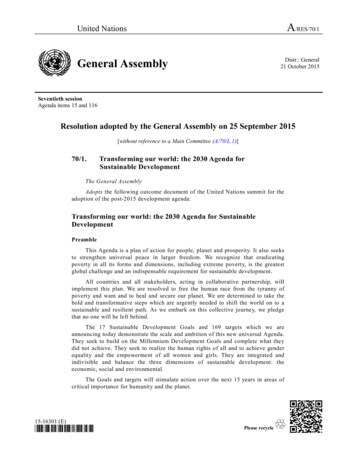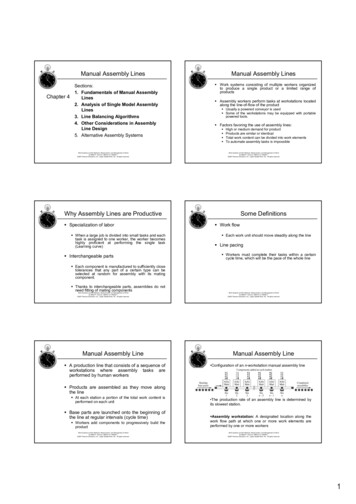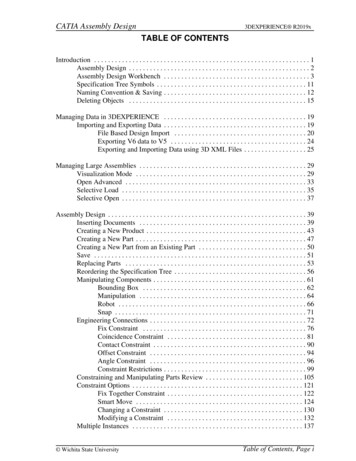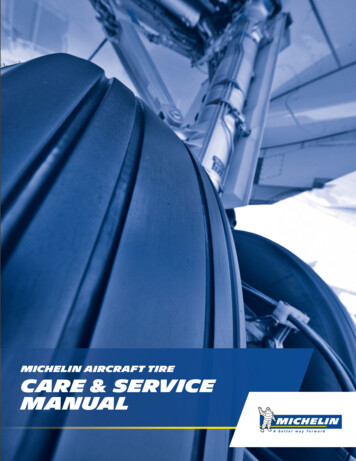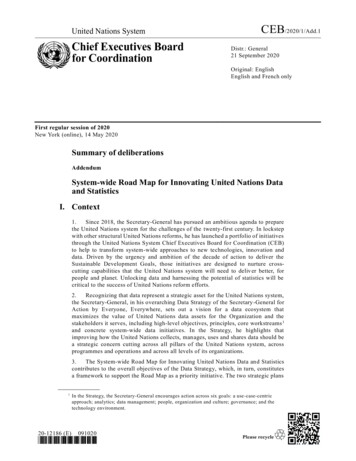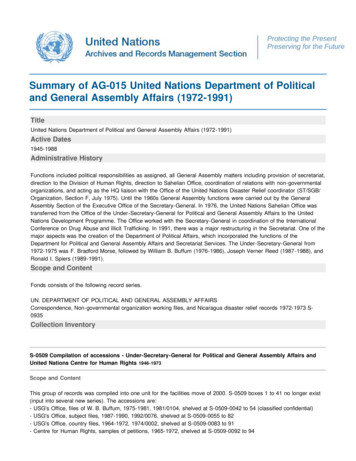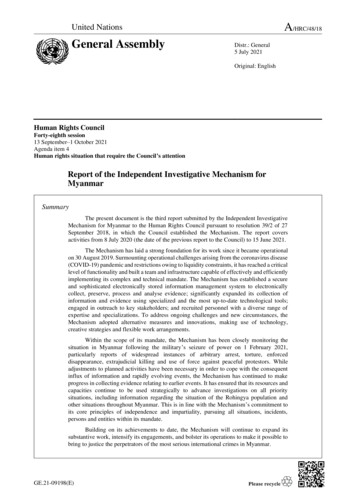
Transcription
A/HRC/48/18United NationsGeneral AssemblyDistr.: General5 July 2021Original: EnglishHuman Rights CouncilForty-eighth session13 September–1 October 2021Agenda item 4Human rights situation that require the Council’s attentionReport of the Independent Investigative Mechanism forMyanmarSummaryThe present document is the third report submitted by the Independent InvestigativeMechanism for Myanmar to the Human Rights Council pursuant to resolution 39/2 of 27September 2018, in which the Council established the Mechanism. The report coversactivities from 8 July 2020 (the date of the previous report to the Council) to 15 June 2021.The Mechanism has laid a strong foundation for its work since it became operationalon 30 August 2019. Surmounting operational challenges arising from the coronavirus disease(COVID-19) pandemic and restrictions owing to liquidity constraints, it has reached a criticallevel of functionality and built a team and infrastructure capable of effectively and efficientlyimplementing its complex and technical mandate. The Mechanism has established a secureand sophisticated electronically stored information management system to electronicallycollect, preserve, process and analyse evidence; significantly expanded its collection ofinformation and evidence using specialized and the most up-to-date technological tools;engaged in outreach to key stakeholders; and recruited personnel with a diverse range ofexpertise and specializations. To address ongoing challenges and new circumstances, theMechanism adopted alternative measures and innovations, making use of technology,creative strategies and flexible work arrangements.Within the scope of its mandate, the Mechanism has been closely monitoring thesituation in Myanmar following the military’s seizure of power on 1 February 2021,particularly reports of widespread instances of arbitrary arrest, torture, enforceddisappearance, extrajudicial killing and use of force against peaceful protestors. Whileadjustments to planned activities have been necessary in order to cope with the consequentinflux of information and rapidly evolving events, the Mechanism has continued to makeprogress in collecting evidence relating to earlier events. It has ensured that its resources andcapacities continue to be used strategically to advance investigations on all prioritysituations, including information regarding the situation of the Rohingya population andother situations throughout Myanmar. This is in line with the Mechanism’s commitment toits core principles of independence and impartiality, pursuing all situations, incidents,persons and entities within its mandate.Building on its achievements to date, the Mechanism will continue to expand itssubstantive work, intensify its engagements, and bolster its operations to make it possible tobring to justice the perpetrators of the most serious international crimes in Myanmar.GE.21-09198(E)
A/HRC/48/18ContentsPageI.Introduction .3II.Progress on the strategic priorities of the Mechanism .3A.Expansion of the collection and preservation of evidence .4B.Analysis and sharing of information .6C.Cooperation arrangements and modalities .9D.Engagement with relevant stakeholders and public outreach .10Operational developments enabling mandate implementation .11A.Foundational policies, protocols and procedures .11B.Infrastructure and technology .12C.Administrative and operational support .12Conclusion .13III.IV.2
A/HRC/48/18I.Introduction1.In its resolution 39/2 of 27 September 2018, the Human Rights Council establishedthe Independent Investigative Mechanism for Myanmar with a mandate to collect,consolidate, preserve and analyse evidence of the most serious international crimes andviolations of international law committed in Myanmar since 2011, and to prepare files inorder to facilitate and expedite fair and independent criminal proceedings, in accordance withinternational law standards, in national, regional or international courts or tribunals. In itsresolution 73/264 of 22 December 2018, the General Assembly welcomed the establishmentof the Mechanism. In a letter dated 27 August 2019 to the President of the Human RightsCouncil, the Secretary-General deemed the Mechanism to be operational as of 30 August2019. The Council, in its resolution 42/3 of 26 September 2019, and the Assembly, in itsresolution 74/246 of 27 December 2019, welcomed the Mechanism’s entry into operation. Inits resolution 43/26 of 22 June 2020, the Council specifically called for the Mechanism toengage in close and timely cooperation on future investigations by, among others, theInternational Criminal Court or the International Court of Justice.2.In less than two years, the Mechanism has developed crucial substantive andoperational capabilities to enable it to make important progress in implementing its mandateand advancing the priorities articulated in the strategy set out in its previous report to theHuman Rights Council.1 Yet ongoing challenges and new developments in Myanmar havesignificantly shaped these priorities, requiring rapid adjustments to operations and creativesolutions. The coronavirus disease (COVID-19) pandemic has continued to restrict theMechanism’s activities, including its ability to travel to engage with relevant stakeholders tocollect and verify evidence, enable cooperation, and advance its outreach efforts, especiallyto witness and victim groups. Reports of widespread instances of arbitrary arrest, torture,enforced disappearance, extrajudicial execution and use of force against peaceful protestersfollowing the military’s seizure of power on 1 February 2021 in Myanmar have given rise toan unprecedented influx of information related to alleged crimes within the Mechanism’smandate that warrant careful monitoring, collection, verification and analysis.3.The Mechanism has been following with deep concern the recent events in Myanmarand has reiterated calls expressed by the Secretary-General and other United Nationsrepresentatives for an end to the violence. The recent events are a stark reminder of thedangers of impunity and the need to ensure accountability for all those who have committedserious international crimes, in order to break the cycle of violence and protect all the peoplesof Myanmar. The Mechanism is committed to fulfilling its unique role and will continue toactively engage with all parts of the international community, in particular Member States inthe region, in order to fully achieve the purpose for which it was created to facilitate justiceand accountability for past serious crimes within its mandate and contribute to the deterrenceof further atrocities.II. Progress on the strategic priorities of the Mechanism4.In 2020, the Mechanism adopted a comprehensive strategy to ensure that it was wellpositioned to achieve full functionality and deliver on its mandate. As detailed in its previousreport to the Council, the strategy focused the Mechanism’s available resources andcapabilities on the following institutional priorities: expanding the collection and analysis ofinformation and evidence; increasing the availability of evidence and analytical documentsfor sharing with courts and tribunals; advancing the development of cooperation frameworkswith new information and assistance providers; and increasing the visibility of theMechanism and strengthen the understanding of its mandate by relevant stakeholders, inparticular witness and victims’ groups. Despite the effects of the COVID-19 pandemic, theMechanism made important progress in multiple areas.1A/HRC/45/60.3
A/HRC/48/18A.Expansion of the collection and preservation of evidence5.The Mechanism aims to conduct the collection of information and evidenceobjectively and professionally, pursuing all situations, incidents, persons and entities withinits mandate. To date, the Mechanism has collected and processed for potential sharing over1.3 million information items from a broad range of sources and covering a variety of formats,including documents, photographs, videos, geospatial imagery, witness statements and opensource materials. The Mechanism collected and processed the majority of this information –over 900,000 information items – after 1 January 2021. Several factors contributed to theseresults, including a strategic orientation of investigative priorities, targeted identification ofpotential information providers, continued monitoring of ongoing developments in Myanmar,the development of capabilities for open-source investigations, and the establishment of asecure and state-of-the-art electronically stored information management system.Investigative priorities6.Taking into account the scope, complexity and diversity of the Myanmar context andcontinuing constraints, the Mechanism continued to develop its investigative activities in amanner that focused on accessible information and evidence while also building thefoundation for longer-term collection and verification efforts. Given the impossibility ofinvestigating all of the crimes committed in Myanmar, the Mechanism developed a specificstrategy for prioritizing the collection and verification of evidence concerning selectedsituations, incidents and individuals and groups suspected of perpetrating crimes. Theobjective is to deploy limited resources in a manner that will allow the Mechanism to buildviable case files proving individual criminal responsibility that are representative of thecrimes committed against various groups in Myanmar. Investigations are prioritized on thebasis of several substantive and operational criteria. These include the scale, nature, mannerof commission and impact of the crimes, including sexual and gender-based crimes andcrimes against children; the degree of responsibility of alleged perpetrators; the prospect ofan investigation meeting international criminal standards; and the likelihood of a court ortribunal taking jurisdiction over the crime(s) in question.7.The strategy helps to guide the targeted identification of potential information sourcesand providers and the collection of information and evidence that is necessary to demonstrateindividual criminal responsibility. Based on an assessment of the materials received from theindependent international fact-finding mission on Myanmar, the Mechanism has alreadyselected certain incidents and situations as priorities.8.Investigating sexual and gender-based crimes and crimes against children is a priorityfor the Mechanism. These crimes are among the gravest of international crimes and requiretargeted outreach and dedicated expertise. The Mechanism’s investigation strategy ensuresthat these crimes continue to be integrated in all investigations, are given particular attentionfrom the outset, and that their full range of criminality, gravity and impact is holisticallyaddressed alongside other conduct, incidents and patterns of crimes, such as the Rohingyacrisis and ethnic conflicts prevailing in northern Myanmar.9.The COVID-19 pandemic continued to have an impact on the implementation of theinvestigation strategy, most notably by preventing the Mechanism from travelling tolocations where potential information providers and witnesses are located. This has curtaileda vital element of the investigative process: verification of existing information and evidencein the Mechanism’s possession and the conduct of in-person data collection and interviewsof witnesses who may have first-hand information regarding the commission of crimes fallingwithin the Mechanism’s mandate. Where possible, the Mechanism continued to placeemphasis on the identification of potential information sources that could be contactedthrough secure electronic means, scaling up the collection and consolidation of informationand evidence through open-source investigations and identifying potential witnesses forfuture in-person interviews.10.In this regard, the Mechanism has made every effort to ensure that any suchengagement is conducted in a safe and secure manner for both stakeholders and Mechanismpersonnel, and that any sensitive information that may be exchanged remains confidential. In4
A/HRC/48/18identifying potential witnesses for interview at a later date, the Mechanism continues tocarefully assess each individual, taking into account various factors, such as the potentialrelevance of the individual’s testimony, the individual’s safety and security and the risk ofretraumatizing the individual.11.However, with respect to the forensic value of witness statements, there is nosubstitute for in-person interviews. Face-to-face interactions are the best method to ensurethe integrity of witness statements. They help build trust between the interviewer and thewitness and allow the interviewer to confirm that the witness is not under any duress or undueinfluence from outside parties. In-person interviews also guarantee the confidentiality of theprocess. They provide an opportunity for Mechanism personnel to address any concerns thatwitnesses may have about their safety and security and to explain to witnesses how theinformation provided will be used. In-person interviews that result in a signed witnessstatement are by far the best method to ensure the information’s usefulness and its broadestpossible admissibility in national, regional and international courts or tribunals.Targeted identification of information providers12.The Mechanism continues to engage with a broad range of information and evidenceproviders, including national authorities, United Nations entities, international organizations,non-governmental organizations, civil society actors, corporate entities and individuals, withthe aim of securing the most relevant materials and information capable of advancing itsmandate. Adjusting for the pandemic, most of these engagements were facilitated throughsecure remote means.13.Since it began operations, the Mechanism made dozens of formal requests forinformation to a variety of such entities and individuals. The majority of those to whom therequests have been addressed have either provided information to the Mechanism or arecurrently in discussions about doing so. In addition, the Mechanism has continued its effortsto initiate cooperation with Member States that may be in possession of information relevantto the Mechanism’s mandate, including the authorities of Myanmar. Where applicable, theMechanism may negotiate cooperation arrangements to enable streamlined processes for theprovision of the material to the Mechanism, as set out below.Monitoring of developments in Myanmar14.As the Mechanism’s mandate is ongoing, the Mechanism also conductscontemporaneous monitoring of developments in Myanmar that may constitute seriousinternational crimes or violations of international law.15.Since the military seized power on 1 February 2021, the Mechanism has experiencedan exponential increase in communications from individuals and organizations seeking toshare information about alleged crimes and human rights violations in Myanmar. From thesesubmissions, the Mechanism has collected over 210,000 information items, including videos,photographs and documents. While the Mechanism was able to temporarily adjust andmobilize critical resources to address this unprecedented influx of information and work, thesituation exposed the need for additional resources and capacity, especially for thecollection and analysis of information and evidence gathered from open sources.Scaling up open-source investigations16.The critical need to collect and analyse open-source information, such as videos,photographs and geospatial imagery publicly available on the Internet or social media,concerns both recent events in Myanmar and earlier incidents that appear to constitute seriousinternational crimes and violations of international law. Open-source information isparticularly valuable for the Mechanism, as the authorities in Myanmar have consistentlydenied the Mechanism access to its territory, preventing on-the-ground investigations in thecountry where the crimes were allegedly committed.17.Given that the availability of open-source information is extensive and has continuedto grow, especially after 1 February 2021, the Mechanism is mobilizing extrabudgetaryresources in order to enhance its capacity to conduct open-source investigations. Specializedcapacity in open-source investigations will enable the Mechanism to use the most advanced5
A/HRC/48/18techniques to collect and analyse such information with efficiency, thoroughness andaccuracy, as well as to systematically document investigative methods and preserve evidencein accordance with international best practices. It will also allow the Mechanism to keepabreast of some of the most innovative and ground-breaking advances taking place ininternational criminal law in the field of open-source investigations.Electronically stored information management systems and cybersecurity18.To facilitate the processing of the growing collection of information and evidence inthe Mechanism’s procession, the Mechanism took concrete steps to expand its physical anddigital storage capacity and to develop a state-of-the art electronically stored managementsystem in line with United Nations standards and industry best practices. The system governsthe entire chain of the Mechanism’s processing of information and evidence in its possession,from collection to organization, preservation, review, analysis and preparation of files forpotential sharing with third parties. This includes a robust system for the management ofpotential evidence, materials and information providers that facilitates the tracking of allinformation requested and collected by the Mechanism and/or shared with third parties. TheMechanism has also improved the processing and accessibility of digital evidence, includingthrough the use of analytical tools and technology services to facilitate the processing ofspecialized videos and natural language material. Such tools will enhance the Mechanism’scapacity to handle more complex data and evidence formats, such as documents, videos,digital images and audio, including open-source materials.19.The Mechanism has prioritized the protection of its information storage system,equipment and tools, which in turn contributes to the protection of its personnel and, crucially,the individuals and organizations engaged by the Mechanism. It has implementedmethodologies and processes within the system to ensure the necessary information securityand cybersecurity, the integrity of the evidence and the required chain of custody. TheMechanism’s cybersecurity framework, which continues to evolve as new threats areidentified, combines responsive and preventive approaches. It allows the Mechanism torespond quickly to all known cybersecurity threats. Through regular training and internalnotifications, the Mechanism is also carrying out its work in line with the latest developmentsin cybersecurity and protective measures.20.Building these technology and cybersecurity capacities from the outset has beeninstrumental in ensuring that the Mechanism has been able to continue its operations in asecure manner with little to no disruption during the COVID-19 pandemic. Furthermore,these efforts have equipped the Mechanism with the ability to share relevant materials in anefficient manner as and when requested by national, regional and international courts andtribunals.Looking ahead21.Notwithstanding the continuing uncertainties related to COVID-19, the Mechanismexpects that the progressive relaxation of travel restrictions will enable the resumption ofessential activities that were suspended during the pandemic. This includes the in-personcollection and verification of information and evidence, as well as high-level engagementmissions to facilitate the negotiation of cooperation arrangements and advance theMechanism’s outreach efforts. The Mechanism will ensure that security considerations areintegrated into all aspects of its mission planning.22.In addition, and to complement other specialized investigative capacities, theMechanism is seeking to enhance its capacities to collect and analyse financial informationas part of its broader investigations into crimes within its mandate. Such information isexpected to complement the Mechanism’s criminal investigations in several ways, includingin identifying potential perpetrators, criminal motives and modes of liability, and inestablishing jurisdictional elements.6
A/HRC/48/18B.Analysis and sharing of information23.While still in the early stages, the Mechanism has put much effort into ensuring thatits analytical work is keeping pace with its growing collection of information and evidence.The Mechanism organizes the evidence collected from many different types of sources andanalyses both specific incidents and broader situations. Through a rigorous assessment, theMechanism seeks to determine what facts can be proven, whether these facts fulfil theelements of crimes within the Mechanism’s mandate, and whether the facts establish thecriminal responsibility of individual perpetrators. This includes situations, incidents andpersons/entities related to the events occurring after 1 February 2021, in addition to situationsrelated to the Rohingya crisis and ethnic conflicts prevailing in northern Myanmar.Developing analytical tools and sharing packages24.Based on its analytical work, the Mechanism has increased the volume of informationand evidence that can be shared for use in national, regional and international courts ortribunals willing or able to hold accountable persons responsible for crimes in theMechanism’s mandate. In line with its investigative strategy, the Mechanism has beenassessing and further developing its analytical capacities and tools covering the broad rangeof alleged crimes and perpetrators in the context of Myanmar. Through this process, theMechanism has determined that information needs to be well organized, collated intocoherent files pertaining to a specific situation, incident or person/entity, and tied together byclear analysis, to ensure that the information will be relevant and useful to investigative,prosecutorial or judicial authorities to the best extent possible. In order to ensure that eachcase file is specific and of a manageable size, the Mechanism is producing compilations, withsupporting information and analysis, that meet the requests of entities for the relevantcriminal or legal proceedings. As at 30 June 2021, the Mechanism has prepared 11compilations of evidence and analysis available for potential sharing.25.Furthermore, the Mechanism is developing analytical tools and products that addresscross-cutting elements, structures and patterns of crimes within its mandate, coveringmultiple situations and incidents that have occurred since 2011. These tools are beingdesigned to be used and applied to multiple case files that the Mechanism is preparing forpotential sharing.26.In addition, the Mechanism has also continued to ensure close and timely cooperationwith the International Criminal Court and the International Court of Justice, as called for bythe Human Rights Council in its resolution 43/26. In The Gambia v. Myanmar, theInternational Court of Justice is currently considering the complaint of the Gambia thatMyanmar is in violation of its obligations under the Convention on the Prevention andPunishment of the Crime of Genocide. The Mechanism continues to share relevant materialswith the parties in the case, after ensuring that it has the consent of the information provider(s)and determining that the information will not affect the security or privacy rights of thosewhom the materials concern.Analysis of events in Myanmar since the military’s seizure of power27.As noted above, the Mechanism’s mandate covers the most serious internationalcrimes and violations of international law committed in Myanmar since 2011. The temporalscope is therefore ongoing and the mandate to collect evidence continues to apply to eventssince the military seizure of power in February of 2021.28. The Mechanism has consistently explained that the constitutional process in Myanmar,fair elections and democracy are not part of its subject matter mandate. The terms of referencefor the Mechanism state that the reference in the mandate to violations of international lawinclude violations of international human rights law and international humanitarian law.Therefore, issues related to violations of the Constitution or the laws of Myanmar, theoverturning or fairness of elections, and who should be recognized as the legal governmentof Myanmar are not within the legal competence of the Mechanism. However, seriousinternational crimes and human rights violations can occur in the context of disputes overpolitical processes within a country. Since the coup, the Mechanism has been carefullyfollowing developments to determine whether recent events constitute crimes that fall withinits mandate.7
A/HRC/48/1829.In addition to preserving and analysing thousands of communications collected fromindividuals and organizations concerning events in Myanmar, the Mechanism has alsoclosely followed public reporting, contacted individuals and entities who have informationabout events, including those who were eyewitnesses, and consulted with persons havingspecialized expertise to assist in the analysis of the information collected.30.The Mechanism’s preliminary analysis of collected information concerning events inMyanmar since the 1 February 2021 military coup indicates that crimes against humanityfalling within the Mechanism’s mandate, including murder, persecution, imprisonment,sexual violence, enforced disappearance and torture, have likely been committed.31.A crime against humanity requires an act committed as part of a widespread orsystematic attack on a civilian population. Such an attack does not need to be a military attack.Rather, it is defined as a course of conduct involving the multiple commission of acts againstany civilian population,2 and it may be carried out in a single location3 or across a broaderswath of territory.4 Acts of violence5 or any serious mistreatment of a civilian population canconstitute an attack for the purposes of establishing a crime against humanity.632.The attack must also be either “widespread” or “systematic”. Determining whether anattack is widespread requires an examination of the scale of the attack and the number ofvictims. When assessing whether an attack is widespread, one must look to the cumulativeeffect of the criminal acts in question, or the impact of a single act of extraordinarymagnitude.7 The geographical scale, temporal scope and number of targeted persons of theattack are all relevant in determining whether an attack was “widespread”.833.Preliminary information collected and analysed by the Mechanism indicates thathundreds of civilians have been killed by security forces across Myanmar, including inYangon, Nay Pyi Taw, Bago, Mandalay, Magway and Sagaing. The available information,including public statements by the military authorities, indicate that thousands of individualshave been arbitrarily detained. Credible reports and video evidence indicate that securityforces have carried out acts of torture and sexual violence. From the totality of theinformation the Mechanism has collected to date, it appears that the events in recent monthsconstitute a widespread attack on a civilian population.34.The attack is similarly systematic in nature. The term “systematic” refers to theorganized nature of the acts of violence and the improbability of their random occurrence. 9Preliminary information collected and analysed by the Mechanism indicates that securityforces have acted in a coordinated manner across the country. Specific groups of individualsappear to have been targeted for arbitrary detention based on their political affiliation,profession (such as medical worker, teacher and journalist) and exercise of political rights.Shortly following the military seizure of power, protests against the coup erupted across the234567898Rome Statute of the International Criminal Court, art. 7 (2) (a).International Criminal Court, Prosecutor v. Katanga, Case No. ICC-01/04-01/07, Judgment pursuantto article 74 of the Statute, 7 March 2014, para. 757 ff.International Criminal Tribunal for the Prosecution of Persons Responsible for Genocide and OtherSerious Violations of International Humanitarian Law Committed in the Territory of Rwanda andRwandan Citizens Responsible for Genocide and Other Such Violations Committed in the Territoryof Neighbouring States between 1 January and 31 December 1994, Bagosora and Nsengiyumva v.Prosecutor, Case No. ICTR-98-41-A, Appeals Chamber Judgment, 14 December 2011, para. 390.Extraordinary Chambers in the Courts of Cambodia, Prosecutor v. Nuon Chea and Khieu Samphan,Case No. 002/01, Trial Chamber Judgment, 7 August 2014, para. 178.International Tribunal for the Prosecution of Persons Responsible for Serious Violations ofIntern
GE.21-09198(E) Human Rights Council Forty-eighth session 13 September-1 October 2021 Agenda item 4 Human rights situation that require the Council's attention Report of the Independent Investigative Mechanism for Myanmar Summary The present document is the third report submitted by the Independent Investigative
